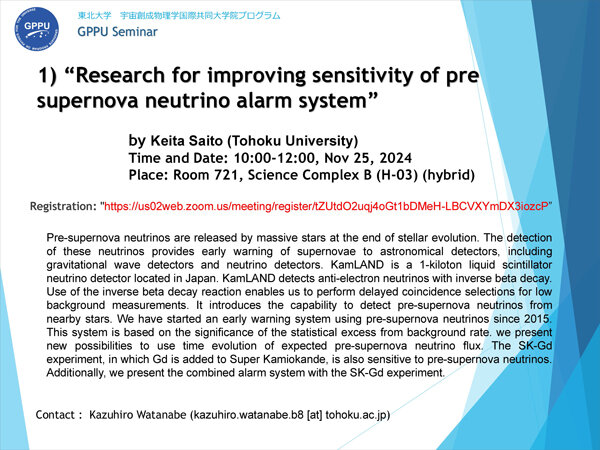お知らせ

- トップ
- お知らせ
GP-PUセミナー開催のご案内
11月25日(月)、以下の内容にて、宇宙創成物理学国際共同大学院(GP-PU)セミナーを開催いたします。
■日 時
2024年11月25日(月)10:00-12:00
■セミナー題目
1) "Research for improving sensitivity of pre supernova neutrino alarm system"
by Keita Saito (Tohoku University)
Pre-supernova neutrinos are released by massive stars at the end of stellar evolution. The detection of these neutrinos provides early warning of supernovae to astronomical detectors, including gravitational wave detectors and neutrino detectors. KamLAND is a 1-kiloton liquid scintillator neutrino detector located in Japan. KamLAND detects anti-electron neutrinos with inverse beta decay. Use of the inverse beta decay reaction enables us to perform delayed coincidence selections for low background measurements. It introduces the capability to detect pre-supernova neutrinos from nearby stars. We have started an early warning system using pre-supernova neutrinos since 2015. This system is based on the significance of the statistical excess from background rate. we present new possibilities to use time evolution of expected pre-supernova neutrino flux. The SK-Gd experiment, in which Gd is added to Super Kamiokande, is also sensitive to pre-supernova neutrinos. Additionally, we present the combined alarm system with the SK-Gd experiment.
2) "Unveiling z>3 heavily obscured AGN missed in X-ray surveys with Spitzer/MIPS: The contribution to the cosmic accretion density at cosmic noon"
by Naoki Matsumoto (Tohoku University)
Supermassive black holes (SMBHs) with masses ranging from several millions to billions times solar mass exist at the centers of almost all massive galaxies in the nearby universe. The large masses of SMBHs in the early universe that are being discovered suggest the need for rapid growth processes like Super-Eddington accretion in the early phase of their growth. The population of active galactic nuclei (AGN) obscured by large amounts of gas and dust in the early universe (i.e., obscured AGN) that is expected to be Super-Eddington phase is said to represent an early violent formation and growth phase of the SMBHs and the host spheroidal components (e.g., Blecha+18), and investigating such population would be a key to understand how SMBHs could gain such a large mass within a limited time scale of the early universe. We performed a MIPS 24um search for z>3 heavily obscured AGN in the XMM-LSS and COSMOS fields, focusing on their strong rest-frame NIR emission originating from AGN hot dust. As a result of the selection, approximately 90% of the selected sources were not detected by the deep X-ray surveys in these fields. SED fitting analysis of all selected candidates revealed that the AGN bolometric luminosities reach log(L_bol)~46-48, indicating that they are heavily obscured and host SMBHs in a vigorous growth phase. The estimated cosmic SMBH growth rate, including heavily obscured AGN, significantly exceeds previous X-ray study estimates. These results emphasize the critical role of obscuration in the early SMBH growth and the importance of this population.
■開催形式
対面×オンライン(Zoom)併用
[対面会場] 理学研究科合同B棟721号室 (キャンパスマップ「H-03」の建物です。)
■参加登録
参加者は事前に下記URLで参加登録が必要です
https://us02web.zoom.us/meeting/register/tZUtdO2uqj4oGt1bDMeH-LBCVXYmDX3iozcP
■Point
GSP = 1
■お問合せ
物理学専攻(GP-PU) 渡邉 和宏
E-mail: kazuhiro.watanabe.b8[at]tohoku.ac.jp
([at]を@に置き換えてください)


Posted on:2024年11月22日